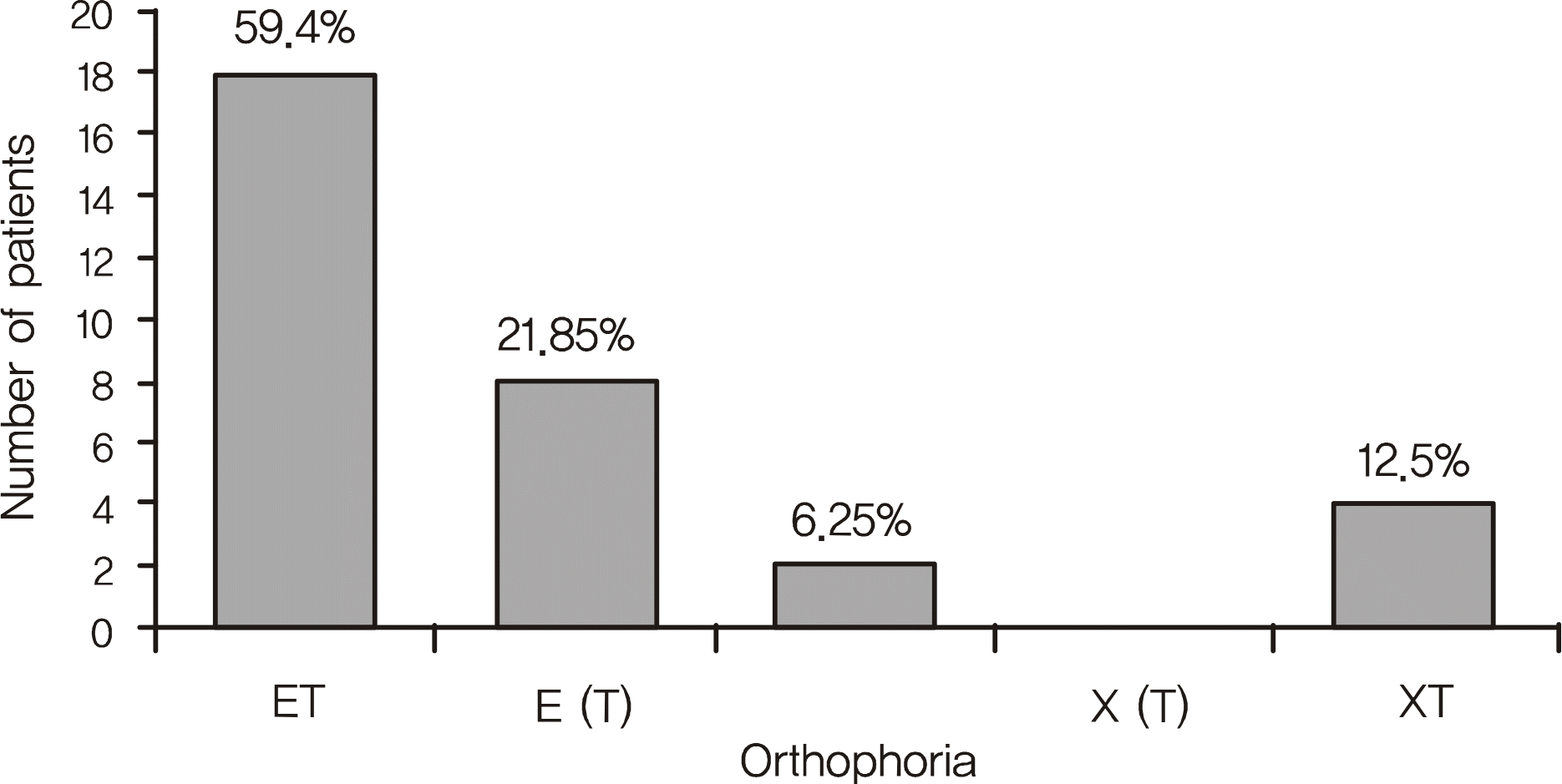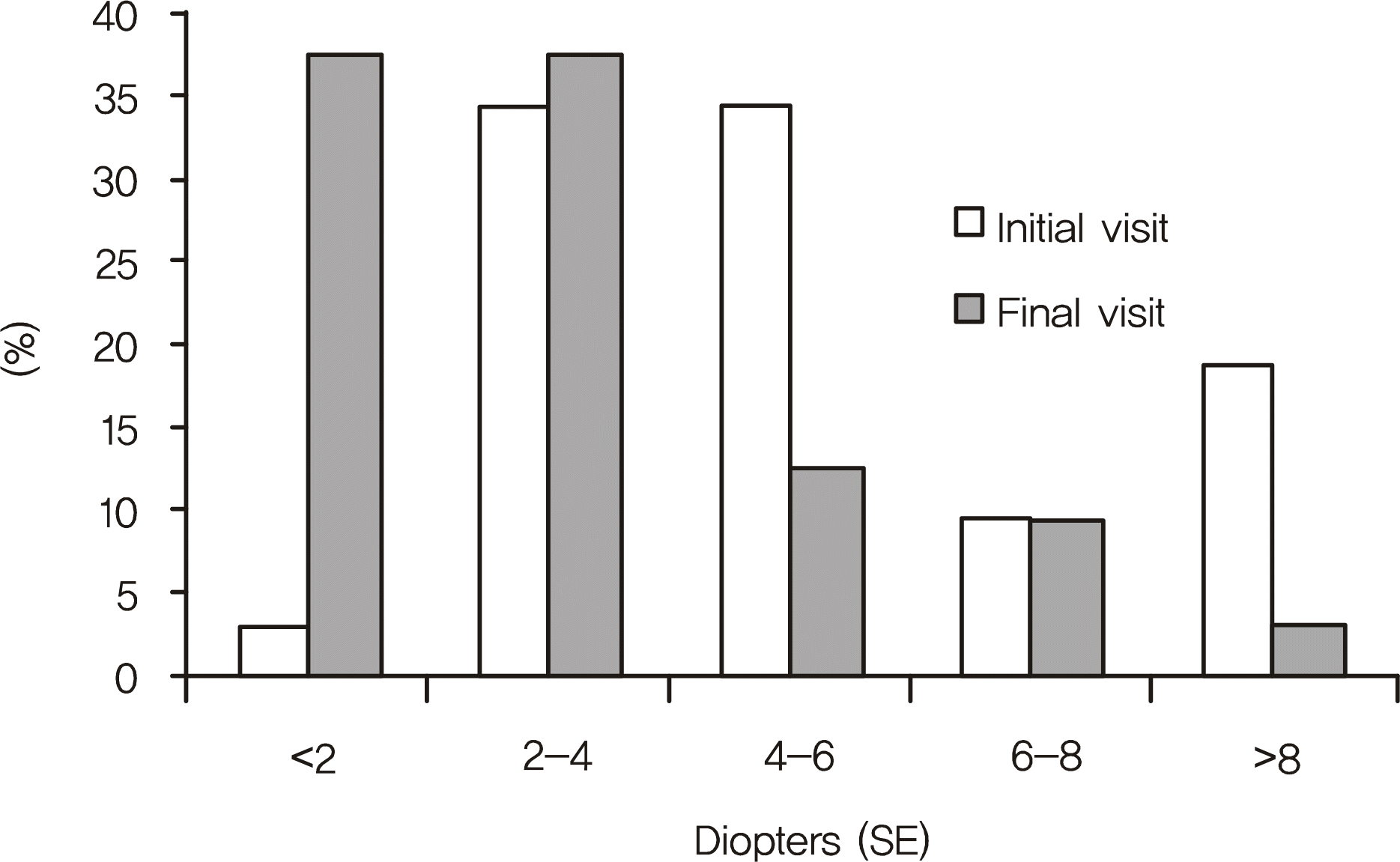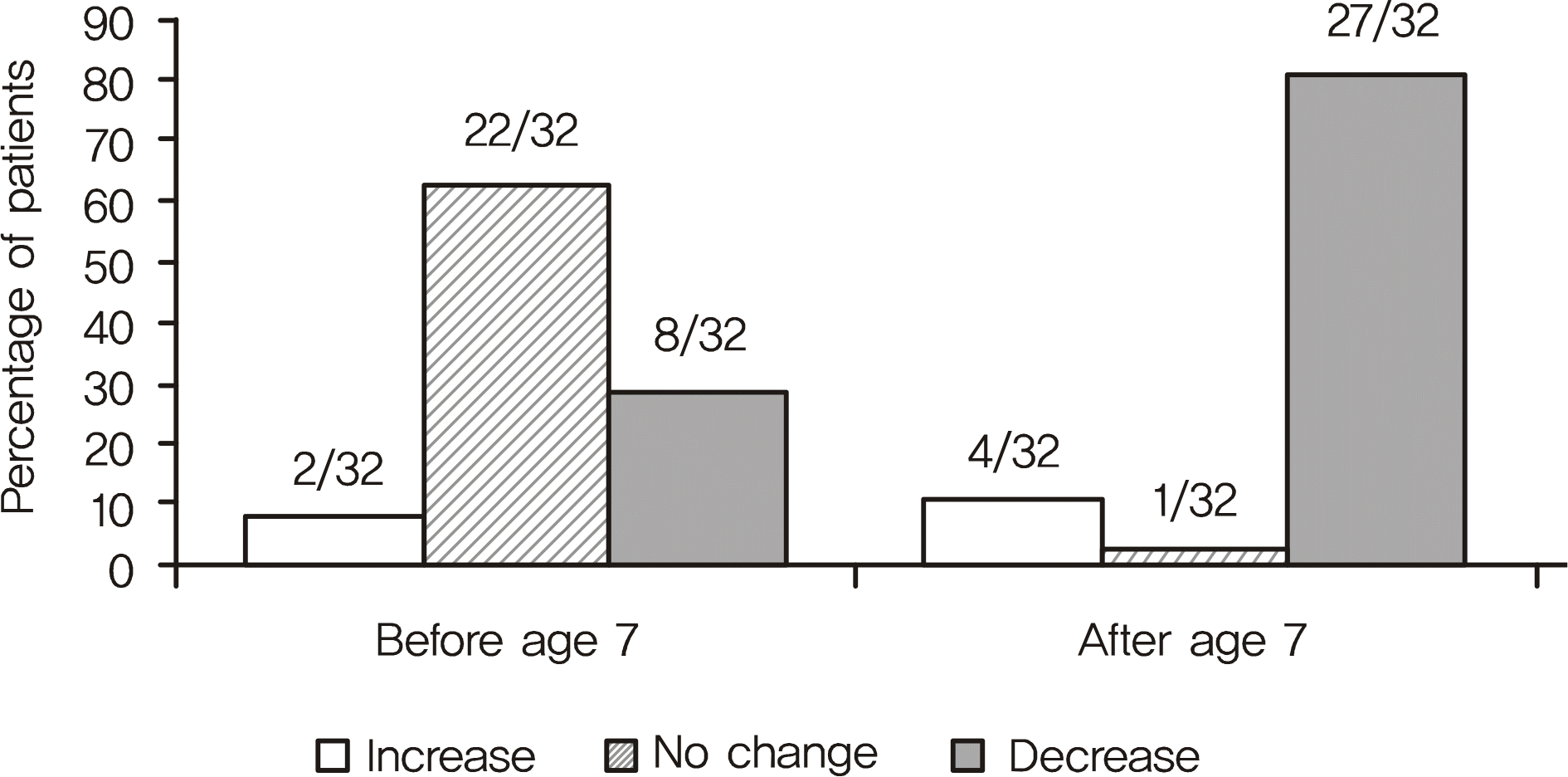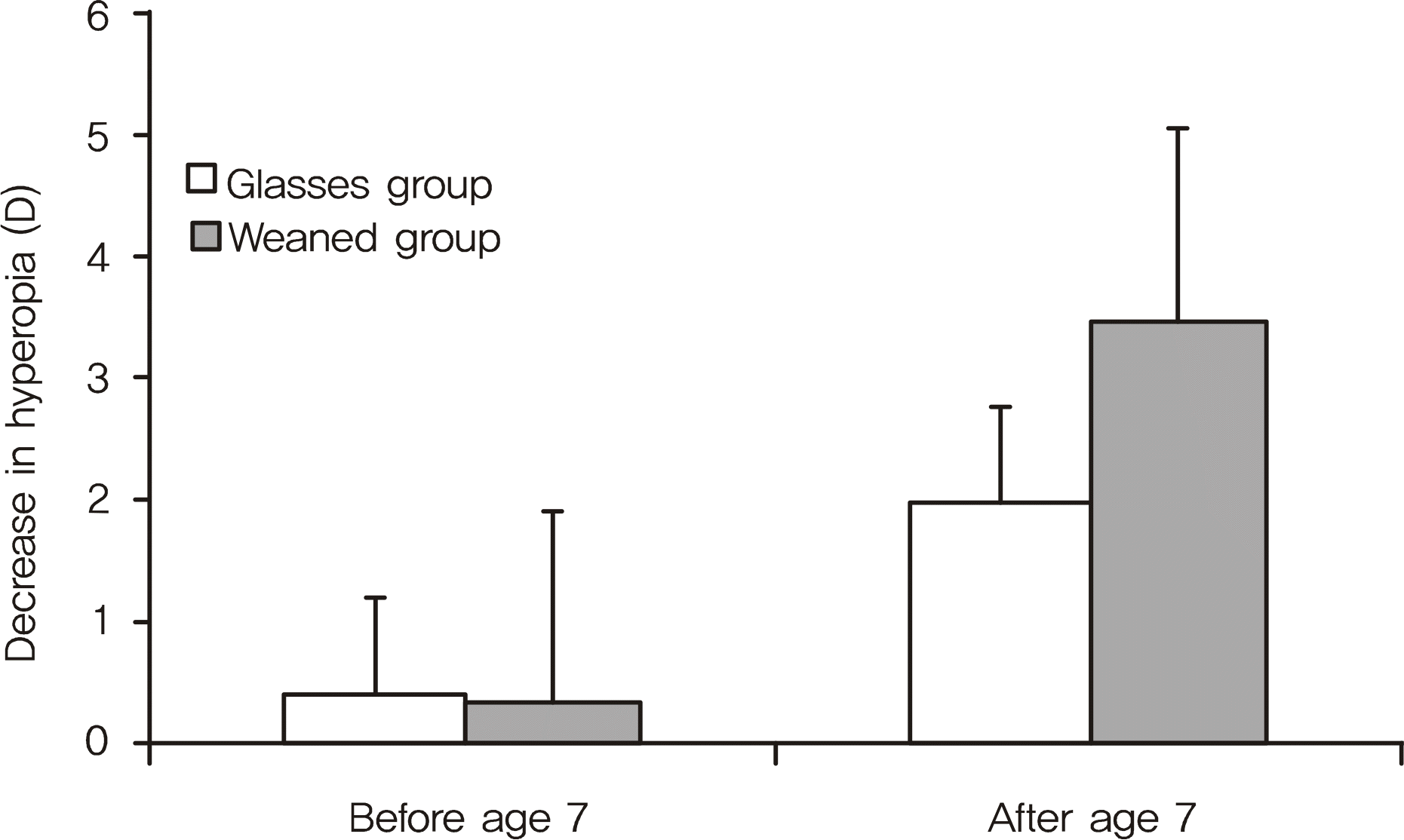Abstract
Purpose
To report the clinical course of refractive accommodative esotropia (AE) and to determine whether the strabismus resolves during the adolescent years in Korean patients.
Methods
A total of 32 adolescent patients with AE associated with hyperopia were retrospectively reviewed. Ocular alignments, amblyopia, stereopsis, changes in refractive error with time after glasses prescribed, and clinical characteristics were studied.
Results
The mean age and follow-up were 14.9 and 10.1 years, respectively at the final visit. The Initial and final refractive errors were 5.16 and 2.52 diopters (D), respectively. Spectacles were initiated at a mean age of 4.7 years, and intentional undercorrection initiated from a mean age of 6.3 years. Hyperopic reduction after prescribing glasses followed the formula: Diopter (D) = 5.23 − 0.02 (Time) − 0.03 (Time)**2. Initially, 16 out of 32 patients (50%) showed fully corrected hyperopia, and eventually, 71.9% wore partially corrected spectacles. The mean change of hyperopia per year was 0.26 D. Six out of 32 patients (18.8%) were successfully discontinued from hyperopic spectacles and the mean age of weaning was 14.7 years. Intentional initial undercorrection did not affect hyperopic reduction (p = 0.123).
Go to : 
References
1. von Noorden GK. Binocular Vision and Ocular Motility. 6th ed.St. Louis: Mosby;2002. p. 311–55.
2. Korean association for pediatric ophthalmology and strabismus. Current Concepts in Strabismus. 2nd ed.Seoul: Naeoehaksul;2008. p. 183–9.
5. Birch EE. Binocular sensory outcomes in accommodative esotropia. J AAPOS. 2003; 7:369–73.
6. Dickey CF, Scott WE. The deterioration of accommodative esotropia: frequency, characteristics, and predictive factors. J Pediatr Ophthalmol Strabismus. 1988; 25:172–5.

7. Mulvihill A, MacCann A, Flitcroft I, O'Keefe M. Outcome in refractive accommodative esotropia. Br J Ophthalmol. 2000; 84:746–9.

8. Berk AT, Koçak N, Ellidokuz H. Treatment outcomes in refractive accommodative esotropia. J AAPOS. 2004; 8:384–8.

9. Swan KC. Accommodative esotropia in long range follow-up. Ophthalmology. 1983; 90:1141–5.
10. Repka MX, Wellish K, Wisnicki HJ, Guyton DL. Changes in the refractive error of 94 spectacle-treated patients with acquired accommodative esotropia. Binocul Vis. 1989; 4:15–21.
11. Na SJ, Choi NY, Park MR, et al. Long-term follow-up results of hyperopic refractive change. J Korean Ophthalmol Soc. 2005; 46:1704–10.
12. Lambert SR, Lynn MJ. Longitudinal changes in the spherical equivalent refractive error of children with accommodative esotropia. Br J Ophthalmol. 2006; 90:357–61.

13. Kim DJ, Chun BY, Kwon J-Y. Five-year follow-up results of refractive accommodative esotropia. J Korean Ophthalmol Soc. 2007; 48:315–20.
14. Lim SJ, Lee SY, Lee YC. Changes of refractive error in patients with refractive accommodative esotropia. J Korean Ophthalmol Soc. 2007; 48:822–7.
15. Kang IS, Park SW, Park YG. Clinical features of refractive accommodative esotropia: Long-trem study. J Korean Ophthalmol Soc. 2008; 49:487–92.
16. Park KA, Kim SA, Oh SY. Effect of age wearing prescription glasses on changes of refractive error in accommodative esotropia. J Korean Ophthalmol Soc. 2009; 50:247–52.

17. Yang H, Chang YH, Lee JB. Clinical features of refractive accommodative esotropia and partially accommodative esotropia. J Korean Ophthalmol Soc. 2004; 45:626–30.
18. Sohn HJ, Paik HJ. Clinical features of refractive accommodative esotropia according to the age of onset. J Korean Ophthalmol Soc. 2006; 47:941–6.
19. Jun JH, Lee YC, Lee SY. Clinical features of refractive accommodative esotropia according to degree of hypermetropia. J Korean Ophthalmol Soc. 2008; 49:617–22.

20. Lambert SR, Lynn M, Sramek J, Hutcheson KA. Clinical features predictive of successfully weaning from spectacles those children with accommodative esotropia. J AAPOS. 2003; 7:7–13.

21. Cho YA, Yi ST, Kim SW. Clinical evaluation of cessation of hyperopia in 123 children with accommodative esotropia treated with glasses for best corrected vision. Acta Ophthalmologica. 2009; 87:532–7.

23. Kubota N, Akatsu S. Long-term follow-up of refractive accommodative esotropia. Campos EC, editor. Strabismus and Ocular Motility disorders. New York, NY: Macmillan;1990. p. 315–8.

24. Taylor RH, Armitage IM, Burke JP. Fully accommodative esotropia in adolescence. Br Orthopt J. 1995; 52:25–8.
25. Rutstein RP, Marsh-Tootle W. Clinical course of accommodative esotropia. Optom Vis Sci. 1998; 75:97–102.

26. Dendy HM, Shaterian E. Practical ocular motility. Springfield, IL: Charles C. Thomas;1967. p. 62–3.
27. Lim SJ, Cho YA. Bilateral hypermetropic amblyopia in children with hyperopia of +6 diopters or more-. J Korean Ophthalmol Soc. 1994; 35:715–20.
28. Brown EBL. Net average yearly change in refraction of atropinized eyes from birth to beyond midlife. Arch Ophthalmol. 1938; 19:719–34.
29. Mntyjrvi MI. Changes of refraction school children. Arch Ophthalmol. 1985; 103:790–2.
30. Raab EL. Etiologic factors in accommodative esodeviation. Trans Am Ophthalmol Soc. 1982; 80:657–94.
31. Raab EL. Hypermetropia in accommodative esodeviation. J Pediatr Ophthalmol Strabismus. 1984; 21:P64–8.
32. Black BC. The influence of refractive error management on the natural history and treatment outcome of accommodative esotorpia. Trans Am Ophthalmol Soc. 2006; 104:303–21.
33. Abrahamsson M, Fabian G, Sjostrand J. Refraction in children developing convergent or divergent strabismus. Br J Ophthalmol. 1992; 76:723–7.
34. Ingram RM, Gill LE, Lambert TW. Effect of spectacles on changes of spherical hypermetropia in infants who did, and did not, have strabismus. Br J Ophthalmol. 2000; 84:324–6.

35. Ingram RM, Gill LE, Lambert TW. Emmetropisation in normal and strabismic children and the associated changes of anisometropia. Strabismus. 2003; 11:71–84.

36. Lim HT, Cho SI, Lee SJ, Park SH. Long-term observations on the emmetropization of the high hyperopia. J Korean Ophthalmol Soc. 2002; 43:1230–7.
37. Atkinson J, Braddick O, Bobier B, et al. Two infant vision screening programmes: prediction and prevention of strabismus and amblyopia from photo- and videorefractive screening. Eye. 1996; 10:189–98.

38. Cho YA, Baek SW. Clinical assessment of accommodative esotropia. J Korean Ophthalmol Soc. 1988; 29:371–8.
Go to : 
 | Figure 3.(A) Hyperopic reduction according to the time after glasses prescribed. (B) Hyperopic reduction according to age. |
 | Figure 5.Changes of hyperopia from the initial visit to the final visit vs the initial hyperopia. |
Table 1.
Amount of initial esodeviation before correction
| Angle of deviation (PD) |
Number of patients |
|
|---|---|---|
| Distance | Near | |
| <20 | 8 (25.0%) | 5 (15.6%) |
| 20 ≤∼< 40 | 19 (59.4%) | 22 (68.8%) |
| 40 ≤ | 5 (15.6%) | 5 (15.6%) |
Table 2.
Comparison of clinical features of initial full correction group and partial correction group
| | Full correction (n = 16) | Partial correction (n = 16) | p Value* |
|---|---|---|---|
| Stereopsis (≤ 100) (%) | 18.8 | 50.0 | 0.039 |
| Fusion at near (%) | 56.2 | 50.0 | 0.961 |
| Fusion at distance (%) | 62.5 | 43.8 | 0.376 |
| Final refraction (D) | 1.75 ± 2.21 | 3.3 ± 2.46 | 0.080 |
| Hyperopic reduction (D) | 3.37 ± 2.05 | 1.92 ± 1.79 | 0.049 |
| Hyperopic reduction rate (D/yr) | 0.33 ± 0.18 | 0.21 ± 0.24 | 0.123 |
Table 3.
Comparison of clinical features of spectacle dependant group and weaned group
Table 4.
Clinical features of patients successfully weaned from spectacle
| Patient No./Sex | Age of first glasses (yr) | Initial ET*(D/N)†(PD) | Final ET*(D/N)†(PD) | Initial refraction‡ OD/OS (D) | Final refraction‡ OD/OS (D) | Age§ discontinuation (yr) |
|---|---|---|---|---|---|---|
| 1/F | 5.0 | 20/25 | 0/2 | +5.00–2.00×180 | +0.25–2.00×180 | 11 |
| | | | | +5.00–1.00×180 | +1.50–1.00×180 | |
| 2/M | 4.5 | 30/30 | 2/8 | +4.25–0.75×180 | +1.50–0.50×180 | 12 |
| | | | | +5.25–1.00×180 | +4.50–1.00×180 | |
| 3/F | 7.0 | 10/10 | 6/6 | +3.50–0.50×180 | +1.75–0.75×180 | 17 |
| | | | | +6.50–0.50×180 | +2.50–0.50×180 | |
| 4/M | 3.5 | 30/30 | 0/0 | +6.00–1.00×180 | −1.00–0.75×180 | 18 |
| | | | | +4.00 | −0.75 | |
| 5/F | 3.5 | 20/20 | 6/6 | +7.00 | +2.00 | 16 |
| | | | | +7.00 | +3.75 | |
| 6/F | 6.5 | 15/20 | 0/0 | +5.75–2.00×15 | +4.25–2.00×20 | 14 |
| | | | | +3.25–0.50×170 | +2.25–0.50×170 | |




 PDF
PDF ePub
ePub Citation
Citation Print
Print






 XML Download
XML Download